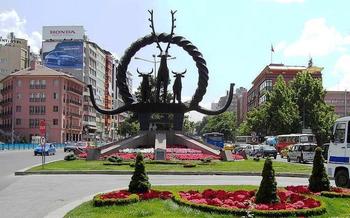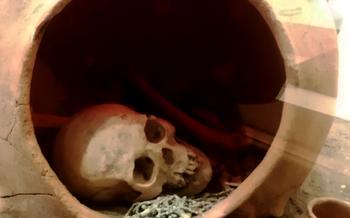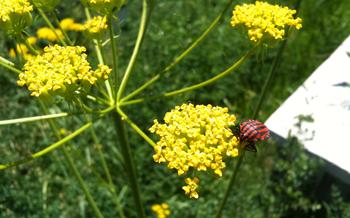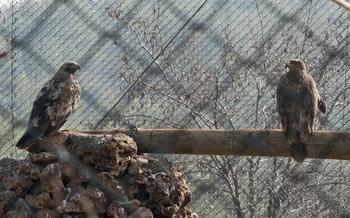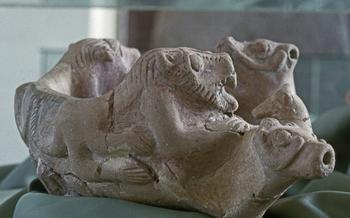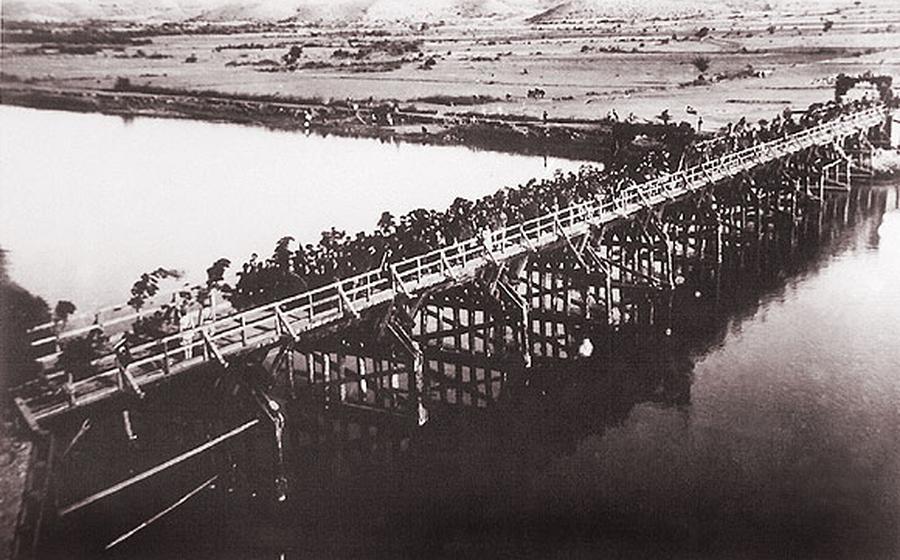
Boğazkale Museum exhibits artifacts from the Hittite period
- Boğazkale Museum: A Journey Through Hittite History
- Unveiling the Hittite Civilization:
- Exploring the Museum's Collections
- The Sphinx Gate: A Majestic Entrance
- The Karahöyük Tablets: A Window into Hittite Law
- Hittite Pottery and Ceramics: Masterpieces of Everyday Life
- Hittite Jewelry: Exquisite Craftsmanship
- Hittite Sculptures: Divine Expressions
- The Royal Road: A Path Through History
- Hattusa: The Hittite Capital
- Alacahöyük: A Royal Hittite City
- Exploring the Hittite Countryside
- Hittite Cuisine: A Taste of History
- Insider Tip: Unveiling Hidden Treasures
Boğazkale Museum: A Journey Through Hittite History
The Boğazkale Museum, nestled in the heart of Çorum, Turkey, embarks visitors on a captivating journey through the annals of the Hittite civilization, one of the most powerful and influential empires of the ancient world. Established in 1968, the museum serves as a treasure trove of Hittite artifacts, providing a glimpse into the rich history, culture, and achievements of this enigmatic people.
Conveniently located in the town of Boğazkale, the museum is easily accessible by road. Its impressive architecture, inspired by traditional Hittite designs, blends harmoniously with the surrounding landscape, creating a sense of timeless connection to the past. As you approach the museum, you'll be greeted by a majestic stone sculpture of a Hittite king, hinting at the grandeur that awaits within.
Once inside, you'll be captivated by the museum's well-curated exhibits, which showcase a diverse collection of artifacts spanning the entire Hittite era. From intricate sculptures and pottery to cuneiform tablets and jewelry, each piece tells a story of a civilization that left an indelible mark on the course of history.
The museum offers a range of guided tours, led by knowledgeable experts who bring the Hittite civilization to life. These tours provide an immersive experience, allowing visitors to delve into the intricacies of Hittite culture, decipher the mysteries of their language, and marvel at their engineering prowess.
Whether you're a history buff, an archaeology enthusiast, or simply curious about ancient civilizations, the Boğazkale Museum promises an unforgettable journey into the heart of the Hittite world. Its treasures will transport you back in time and leave you in awe of the achievements of this remarkable people.
Unveiling the Hittite Civilization:
The Hittites were an ancient people who established a powerful empire in Anatolia during the Bronze Age. Their origins remain shrouded in mystery, but they are believed to have migrated from the Caucasus region around the 20th century BCE. Over time, they expanded their territory, conquering vast swaths of land and establishing a formidable empire that rivaled the great powers of the time, including Egypt and Babylonia.
The Hittites were renowned for their advanced civilization, leaving behind a rich legacy of art, architecture, and written records. Their empire was characterized by a sophisticated administrative system, a complex legal code, and a vibrant religious tradition. They were skilled in metallurgy, producing intricate bronze objects and weapons, and were also accomplished builders, constructing impressive fortifications, temples, and palaces.
One of the most remarkable aspects of Hittite civilization was their language, which was distinct from any other known language of the ancient world. The decipherment of Hittite cuneiform, the script used by the Hittites, in the early 20th century was a groundbreaking achievement that allowed scholars to access a wealth of information about their history, culture, and beliefs.
The Hittites were a deeply religious people, worshiping a pantheon of gods and goddesses. Their religious beliefs and practices were influenced by various Mesopotamian and Anatolian cultures, and they played a central role in their society, influencing everything from politics to daily life.
Exploring the Museum's Collections
The Boğazkale Museum houses a treasure trove of artifacts that offer a glimpse into the rich history and culture of the Hittite civilization. Sculptures, pottery, jewelry, and tablets are just a few examples of the diverse objects on display.
Among the most significant artifacts are the Hittite tablets, which provide invaluable insights into the history, laws, and administration of this ancient empire. These tablets, written in cuneiform script, cover a wide range of topics, including laws, treaties, and administrative records. They shed light on the legal system, social structure, and political organization of the Hittite kingdom.
The museum's collection also features stunning examples of Hittite art and craftsmanship. The Sphinx Gate, a monumental entrance gate adorned with impressive reliefs of sphinxes, is a testament to the architectural prowess of the Hittites. The Karahöyük Tablets, on the other hand, are a remarkable collection of legal documents that provide a detailed glimpse into the Hittite legal system.
The artifacts in the Boğazkale Museum are meticulously organized and presented, allowing visitors to easily navigate the collection and gain a comprehensive understanding of Hittite history and culture. Each exhibit is accompanied by informative labels and descriptions, providing visitors with the context and significance of the artifacts on display.
The Sphinx Gate: A Majestic Entrance
The Sphinx Gate is one of the most iconic landmarks of the ancient Hittite city of Hattusa and a highlight of the Boğazkale Museum. Built in the 13th century BC, the gate served as a grand entrance to the city and symbolized its power and prestige.
The gate's most striking feature is its pair of massive sphinxes, which stand over 2 meters tall. Carved from a single block of stone, these majestic creatures have human heads wearing elaborate headdresses and the bodies of lions. The sphinxes are adorned with intricate carvings that depict their muscles, fur, and even their claws. They seem to come to life, ready to guard the city and intimidate any potential invaders.
The architectural style of the gate is typically Hittite, with its large stone blocks and corbelled arch construction. The arch is formed by gradually overlapping the stones, creating a stable and durable structure without the use of mortar. The gate's walls are decorated with reliefs depicting various deities and royal figures, adding to its grandeur and significance.
Beyond its historical importance, the Sphinx Gate is a testament to the artistic prowess of the Hittites. The intricate carvings, the powerful symbolism, and the sheer scale of the gate are awe-inspiring. It's easy to imagine the sense of wonder and awe that visitors to Hattusa must have felt as they passed through this magnificent gate.
The Karahöyük Tablets: A Window into Hittite Law
In 1946, a remarkable discovery was made at the ancient Hittite city of Karahöyük: a collection of clay tablets containing laws, treaties, and administrative records that shed new light on the legal system and society of the Hittites. These tablets, known as the Karahöyük Tablets, are considered one of the most important finds in Hittite archaeology.
The Karahöyük Tablets provide valuable insights into various aspects of Hittite law. Among the most significant are the laws governing marriage, family, property, and inheritance. The tablets reveal that the Hittites had a well-developed legal system that protected the rights of individuals and ensured the smooth functioning of society.
One of the most fascinating aspects of the Karahöyük Tablets is the evidence they provide of the Hittites' international relations. The tablets contain treaties between the Hittites and other nations, such as the Egyptians and the Babylonians. These treaties provide valuable information about the political and diplomatic interactions between these ancient civilizations.
Despite their importance, the Karahöyük Tablets have also been the subject of challenges and controversies. One of the main challenges lies in the interpretation of the tablets. The Hittite language is complex and not fully understood, and some of the legal terms used in the tablets are still debated by scholars.
Another challenge is the fragmentary nature of the tablets. Many of the tablets are broken or incomplete, and some sections are missing. This has made it difficult for scholars to reconstruct the complete picture of Hittite law.
Despite these challenges, the Karahöyük Tablets remain a valuable source of information about the Hittites and their legal system. They provide a unique glimpse into the workings of an ancient civilization and offer insights into the development of law and society in the ancient Near East.
Hittite Pottery and Ceramics: Masterpieces of Everyday Life
The Hittites were skilled potters who produced a wide variety of ceramic vessels for both practical and decorative purposes. Their pottery was made from local clay and fired in kilns, resulting in a durable and versatile material. Hittite potters used a variety of techniques, including wheel-throwing, hand-building, and molding, to create vessels of various shapes and sizes.
The most common type of Hittite pottery was the storage jar, which was used to store food and other goods. These jars were typically large and had a wide mouth and a narrow base, making them easy to fill and empty. Other types of pottery included bowls, plates, cups, and jugs, which were used for eating, drinking, and serving food.
Hittite pottery was often decorated with a variety of motifs, including geometric patterns, floral and animal designs, and human figures. These motifs were applied using a variety of techniques, such as painting, carving, and stamping. The colors used in Hittite pottery were typically earth tones, such as brown, red, and orange.
Hittite pottery played an important role in everyday life, as it was used for a variety of purposes, from cooking and eating to storage and transportation. It was also a valuable commodity that was traded throughout the Hittite Empire and beyond. The high quality and artistry of Hittite pottery is a testament to the skill and creativity of these ancient artisans.
Hittite Jewelry: Exquisite Craftsmanship
The Hittites were renowned for their exquisite jewelry, which showcased their exceptional craftsmanship and artistic talent. They produced a wide range of jewelry pieces, including necklaces, bracelets, earrings, and rings, each adorned with intricate designs and made from precious materials such as gold, silver, and semi-precious stones.
Hittite jewelry was not merely decorative; it also held significant cultural and symbolic value. Necklaces, for example, were often adorned with pendants depicting protective deities or symbols of power and status. Bracelets and earrings were believed to ward off evil spirits and bring good fortune to the wearer. Rings, meanwhile, were often used to seal important documents or to signify marital status.
The intricate designs and motifs found on Hittite jewelry are a testament to the skill and creativity of their artisans. They incorporated elements from nature, such as flowers, animals, and insects, as well as geometric patterns and abstract symbols. The level of detail and precision in their work is truly remarkable, especially considering the limited tools and techniques available to them at the time.
The discovery of Hittite jewelry in archaeological excavations has provided valuable insights into their culture, social hierarchy, and religious beliefs. The sheer quantity and variety of jewelry found suggest that it was widely worn by people of all social classes, from royalty to commoners. The presence of jewelry in burials indicates that it was also considered to have religious significance, perhaps as a means of ensuring protection and prosperity in the afterlife.
Today, Hittite jewelry continues to captivate and inspire with its beauty and craftsmanship. Many museums around the world, including the Boğazkale Museum, display exquisite examples of Hittite jewelry, allowing visitors to admire the artistry and cultural significance of these ancient treasures.
Hittite Sculptures: Divine Expressions
The Hittites were skilled sculptors who created a wide range of sculptures, including statues, reliefs, and figurines. These sculptures served various purposes, from religious devotion to political propaganda.
Hittite sculptures were typically carved from stone, such as basalt and limestone, or cast in metal, such as bronze and gold. The artists demonstrated remarkable technical skill and attention to detail, capturing the physical features and expressions of their subjects with great realism.
One of the most iconic Hittite sculptures is the Sphinx Gate, which guarded the entrance to the royal city of Hattusa. The gate features two monumental sphinxes carved from a single block of stone. The sphinxes have human heads and lion bodies and are adorned with elaborate headdresses and jewelry. They symbolize strength, power, and protection.
Other notable Hittite sculptures include the Karahöyük Sphinx, a smaller but equally impressive sphinx carved from basalt, and the Alacahöyük Reliefs, which depict various scenes from Hittite mythology and history.
Hittite sculptures played a significant role in religious ceremonies and rituals. They were often placed in temples and other sacred spaces to honor the gods and goddesses. The sculptures were believed to be imbued with divine power and were used as a means of communicating with the deities.
In addition to their religious significance, Hittite sculptures were used to commemorate important events and glorify the achievements of the Hittite kings. Royal sculptures were often displayed in palaces and public spaces to reinforce the authority and power of the monarchy.
The Hittite sculptures that have survived to this day provide valuable insights into the artistic, religious, and political life of the Hittite civilization. They are a testament to the skill and creativity of Hittite artists and offer a glimpse into the rich cultural heritage of this ancient Anatolian kingdom.
The Royal Road: A Path Through History
The Royal Road, also known as the King's Highway, was a crucial infrastructure project undertaken by the Hittite Empire. This ancient highway stretched for over 1,500 kilometers, connecting the Hittite capital of Hattusa with other major cities and regions under their influence. The road served as a vital artery for trade, communication, and cultural exchange, facilitating the movement of goods, ideas, and people across the vast Hittite Empire.
The construction and maintenance of the Royal Road were significant achievements, demonstrating the engineering prowess and organizational skills of the Hittites. The road was meticulously planned and built, taking into account factors such as terrain, water sources, and strategic locations. It featured well-maintained surfaces, bridges, and milestones to guide travelers along the way.
The Royal Road played a pivotal role in facilitating trade and commerce within the Hittite Empire. Merchants and traders from diverse regions used the road to transport their goods, contributing to the economic prosperity of the empire. The movement of goods along the road also led to cultural exchange and the spread of new ideas and technologies.
However, traveling on the Royal Road was not without its challenges. The vast distances, rugged terrain, and potential threats from bandits or hostile forces made the journey arduous and perilous. Travelers had to contend with extreme weather conditions, limited access to supplies, and the need to navigate through unfamiliar territories. Despite these challenges, the Royal Road remained a critical lifeline for the Hittite Empire, enabling the efficient movement of people, goods, and ideas across its vast domains.
Hattusa: The Hittite Capital
In the heart of Anatolia lies the ancient city of Hattusa, once the thriving capital of the Hittite Empire. Founded around 1600 BC, Hattusa stood as a testament to the power and grandeur of the Hittites. Its strategic location at the crossroads of trade routes made it a center of commerce and cultural exchange.
As you approach Hattusa, its imposing fortifications greet you. The city walls, constructed from massive stone blocks, stretch for kilometers, hinting at the impregnability of this ancient metropolis. Inside the walls, a labyrinth of streets and alleys unfolds, lined with the remnants of temples, palaces, and administrative buildings.
The most prominent structure in Hattusa is the Great Temple, dedicated to the Hittite storm god, Teshub. Its colossal size and elaborate decorations speak volumes about the religious significance of this temple. The intricate carvings on its walls depict scenes from Hittite mythology, providing glimpses into their beliefs and practices.
Other notable landmarks in Hattusa include the Royal Palace, where the Hittite kings resided, and the Sphinx Gate, a monumental entrance guarded by majestic stone sphinxes. The Sphinx Gate serves as a reminder of the Hittites' architectural prowess and their ability to blend artistic expression with functionality.
Exploring Hattusa is like stepping back in time. The ruins of this once-great city offer a tangible connection to the Hittite civilization. As you wander through its streets, you can almost feel the presence of the Hittite kings and queens who once ruled this land. Hattusa is a place where history comes alive, inviting you to unravel the mysteries of one of Anatolia's most enigmatic civilizations.
Alacahöyük: A Royal Hittite City
Alacahöyük, located about 50 kilometers southwest of Çorum, is another significant site related to the Hittite civilization. Excavations at Alacahöyük have revealed the remains of a royal Hittite city that dates back to the 14th century BCE. The city was once a major center of power and influence in the Hittite Empire.
Among the most impressive discoveries at Alacahöyük is the Sphinx Gate, which is similar to the one found at Hattusa. The gate is flanked by two massive sphinxes carved from a single block of stone. The sphinxes are adorned with intricate carvings and inscriptions that provide valuable insights into Hittite mythology and symbolism.
In addition to the Sphinx Gate, Alacahöyük has yielded a wealth of other artifacts, including gold and silver jewelry, bronze weapons, pottery, and tablets written in cuneiform script. These artifacts shed light on the artistic, technological, and cultural achievements of the Hittites.
Alacahöyük is a must-visit site for anyone interested in Hittite history and archaeology. The site offers a glimpse into the grandeur and sophistication of the Hittite civilization and provides a fascinating complement to the exhibits at the Boğazkale Museum.
Exploring the Hittite Countryside
The Hittite region is a treasure trove of natural beauty and diverse landscapes, beckoning travelers to explore its hidden gems. Majestic mountains, lush forests, sparkling rivers, and fertile plains paint a breathtaking canvas that will captivate your senses.
For outdoor enthusiasts, the Hittite countryside offers a plethora of adventures. Embark on invigorating hikes through rugged terrains, where you'll be rewarded with panoramic views that stretch for miles. Immerse yourself in the serenity of nature as you camp under a canopy of stars, listening to the gentle sounds of the wilderness. Birdwatching enthusiasts will delight in the region's rich avian diversity, spotting colorful species that flit among the trees and soar through the skies.
Venture beyond the beaten path and visit local villages, where you'll be warmly welcomed by the friendly people of the region. Engage in meaningful conversations, learn about their traditions and customs, and savor the authentic flavors of their cuisine. Immerse yourself in the vibrant local markets, where you can barter for unique handicrafts and souvenirs that reflect the region's rich cultural heritage.
To fully embrace the beauty of the Hittite countryside, consider planning a road trip or trek. Rent a car and embark on a journey that will take you through picturesque landscapes, charming towns, and ancient ruins. For a more immersive experience, opt for a guided tour led by knowledgeable locals who can share fascinating insights into the region's history, culture, and natural wonders.
As you traverse the Hittite countryside, keep your eyes peeled for hidden gems that often lie off the beaten path. Discover secluded waterfalls, explore mysterious caves, and stumble upon ancient ruins that whisper tales of a bygone era. Don't forget your camera to capture the breathtaking moments and share your adventures with the world.
Hittite Cuisine: A Taste of History
Traditional Hittite Delicacies: - Explore the culinary heritage of the Hittites through traditional dishes that have stood the test of time. - Sample mouthwatering kebabs marinated in aromatic spices and grilled to perfection. - Indulge in "keşkek," a hearty stew made from wheat, meat, and chickpeas, a staple in Hittite cuisine. - Savor "mantı," delicate dumplings filled with minced meat and yogurt sauce, a beloved dish with a long history. - Satisfy your sweet tooth with "helva," a delectable dessert made from sesame seeds and honey, a true reflection of Hittite culinary artistry.
Local Ingredients and Flavors: - Discover the unique flavors of Hittite cuisine, crafted with fresh, locally sourced ingredients. - Herbs such as mint, thyme, and oregano add a burst of aromatic freshness to many dishes. - Experience the tangy zest of locally grown lemons and pomegranates, adding a vibrant touch to various recipes. - Delight in the rich, creamy flavors of yogurt, a staple ingredient in Hittite cooking, used in everything from soups to desserts.
Recommended Eateries in Çorum: - Embark on a culinary journey at "Hitit Sofrası," a renowned restaurant showcasing authentic Hittite cuisine in a warm and inviting ambiance. - Visit "Çorum Konağı," a charming establishment housed in a historic mansion, offering a delightful fusion of traditional Hittite dishes with a modern twist. - For a casual dining experience, head to "Kebapçıoğlu," a local favorite known for its delectable kebabs and grilled meats, sure to satisfy any meat lover's cravings.
Tips for Special Dietary Needs: - Vegetarians can rejoice in the abundance of fresh vegetables, legumes, and dairy products available in Hittite cuisine. - For those with gluten sensitivities, explore the variety of gluten-free options, such as grilled meats, fresh salads, and yogurt-based dishes. - If you have specific dietary restrictions, don't hesitate to inquire with restaurant staff or seek guidance from knowledgeable locals.
Insider Tip: Unveiling Hidden Treasures
As you wander through the Boğazkale Museum, keep an eye out for some hidden gems that often go unnoticed by the casual visitor. In a discreet corner of the museum, you'll find a collection of intricate Hittite seals, each one a tiny masterpiece telling a unique story. These seals were used to authenticate documents and mark ownership, and they offer a fascinating glimpse into the daily lives of the Hittites.
Another hidden treasure is the museum's collection of Hittite musical instruments. These instruments, including lyres, drums, and cymbals, provide a glimpse into the vibrant musical traditions of the Hittites. Imagine the sounds of these ancient instruments resonating through the halls of Hattusa, accompanying religious ceremonies or joyous celebrations.
To delve deeper into the Hittite civilization, consider booking a guided tour with a local expert. These knowledgeable guides can provide personalized insights into the artifacts and their significance, bringing the history of the Hittites to life. They can also recommend lesser-known sites in the region, such as ancient ruins or hidden gems off the beaten path.
When visiting the museum, remember to capture the beauty of the artifacts and the ambiance of the museum through photographs. The intricate carvings, majestic sculptures, and unique exhibits offer plenty of Instagram-worthy moments. Just be sure to respect the museum's guidelines regarding photography and avoid using flash, which can damage the delicate artifacts.
By exploring these hidden gems and seeking out the insider knowledge of local guides, you'll gain a deeper appreciation for the rich history and enduring legacy of the Hittite civilization.

